Estimating Housing Vacancy Rate Using Nightlight and POI: A Case Study of Main Urban Area of Xi’an City, China
Abstract
:1. Introduction
2. Study Area and Data
3. Method
- (1)
- Pre-processing of the Luojia-1 and POI data. Geometric correction, radiation correction, and mask processing were used to preprocess the Luojia-1 data, and kernel density analysis was performed to obtain the same resolution as the Luojia-1.
- (2)
- Extraction of built-up areas. The LJ&POI index was constructed by using the treated Luojia-1 and POI data, and then the threshold was determined according to the method of Li [36] to extract the built-up area of the main urban area of Xi’an city.
- (3)
- Estimation HVR. It was necessary to remove the influence of roads and nonresidential areas on the basis of built-up areas to obtain the actual DN value of residential areas because the main research object was residential areas. The DN value in the case of a full residential area was determined. The result was calculated from the ratio of the DN value between a residential area and a full residential area.
3.1. Data Processing
3.2. Extraction of the Built-Up Areas
3.3. Estimation of the HVR
4. Results
4.1. Spatial Distribution of Vacant Housing
4.2. Analysis of the Results
5. Discussion
5.1. Validation of the Estimated HVR
5.2. Comparison of the Results
5.3. Highlights and Limitations
- (1)
- Although this paper used the highest resolution Luojia-1 nighttime light data (spatial resolution: 130 m) that can be obtained at present, such a spatial resolution was still lower and insufficient for conducting urban internal research. The accuracy is slightly unsatisfactory.
- (2)
- Nighttime light data are susceptible to the urban area light intensity, fire, exhaust gas combustion, and many other background noises. At present, researchers have proposed noise reduction, calibration, desaturation, and other processing methods, but there is no universally accepted method. Although the Luojia-1 data used in this paper greatly reduced the saturation spillover effect, the measurement error will still have an impact on the accuracy of the housing vacancy estimate.
- (3)
- In many cities, especially in megacities, the urban built-up area and the night lighting area do not necessarily coincide strictly, the separation of work and housing is widespread, and there is no strict proportional relationship between the strength of the light and the housing vacancy. The higher the degree of separation between work and housing, the greater the impact on the estimation of the HVRs.
5.4. Policy Implications
- (1)
- In areas with serious housing vacancy problems, such as the suburbs, it is recommended to limit large-scale real estate development, strictly control the number of houses, and avoid oversupply. However, the vacancy rate in the city center was low, which indicates that there is a high demand for housing in these areas. Authorities should provide more housing for home buyers/renters, ensure the housing supply, and alleviate housing pressure. For example, housing needs can be met by increasing the proportion of plots in urban areas.
- (2)
- We suggest guiding developers to develop rationally and avoid blindly developing large and high-priced houses to pursue profits, resulting in a mismatch between the supply and demand structure.
- (3)
- For areas with high altitudes, due to the fact of remoteness and other reasons, it is recommended to further strengthen the construction of housing infrastructure, provide residents with convenient transportation, mature and perfect facilities, etc., to meet the convenience needs of residents in work and daily life.
- (4)
- Finally, we also suggest curbing speculation by some developers (e.g., overselling) that lead to a large number of vacant homes.
6. Conclusions
Author Contributions
Funding
Institutional Review Board Statement
Informed Consent Statement
Data Availability Statement
Acknowledgments
Conflicts of Interest
References
- Wuyts, W.; Sedlitzky, R.; Morita, M.; Tanikawa, H. Understanding and managing vacant houses in support of a material stock-type society—The case of Kitakyushu, Japan. Sustainability 2020, 12, 5363. [Google Scholar] [CrossRef]
- Kelling, G.L.; Wilson, J.Q. Broken Windows: The Police and Neighborhood Safety; The Atlantic Daily: Washington, DC, USA, 1982; Volume 249, pp. 29–38. [Google Scholar]
- Han, H.-S. The impact of abandoned properties on nearby property values. Hous. Policy Debate 2014, 24, 311–334. [Google Scholar] [CrossRef]
- Kato, H. Total Fertility Rate, Economic–Social Conditions, and Public Policies in OECD Countries. In Macro-Econometric Analysis on Determinants of Fertility Behavior; Springer: Berlin/Heidelberg, Germany, 2021; pp. 51–76. [Google Scholar]
- Xu, H.; Rong, C. Changes in China’s Housing Demand and Suggestions for Countermeasures in the “14th Five-Year Plan” Period. Macroeconomics 2021, 8, 151–167. [Google Scholar]
- Jin, X.; Long, Y.; Sun, W.; Lu, Y.; Yang, X.; Tang, J. Evaluating cities’ vitality and identifying ghost cities in China with emerging geographical data. Cities 2017, 63, 98–109. [Google Scholar] [CrossRef]
- Han, X.; Zhang, M.; Hu, Y.; Huang, Y. Study on the Digital Transformation Capability of Cost Consultation Enterprises Based on Maturity Model. Sustainability 2022, 14, 10038. [Google Scholar] [CrossRef]
- Du, M.; Wang, L.; Zou, S.; Shi, C. Modeling the census tract level housing vacancy rate with the Jilin1-03 satellite and other geospatial data. Remote Sens. 2018, 10, 1920. [Google Scholar] [CrossRef] [Green Version]
- Lu, D. Urbanization Process and Spatial Sprawl in China. Urban Plan. Forum 2007, 4, 47–52. [Google Scholar]
- Zhao, S.; Li, W.; Zhao, K.; Zhang, P. Change Characteristics and Multilevel Influencing Factors of Real Estate Inventory—Case Studies from 35 Key Cities in China. Land 2021, 10, 928. [Google Scholar] [CrossRef]
- Yin, L.; Silverman, R.M. Housing abandonment and demolition: Exploring the use of micro-level and multi-year models. ISPRS Int. J. Geo-Inf. 2015, 4, 1184–1200. [Google Scholar] [CrossRef] [Green Version]
- Chen, Z.; Yu, B.; Hu, Y.; Huang, C.; Shi, K.; Wu, J. Estimating house vacancy rate in metropolitan areas using NPP-VIIRS nighttime light composite data. IEEE J. Sel. Top. Appl. Earth Obs. Remote Sens. 2015, 8, 2188–2197. [Google Scholar] [CrossRef]
- Di Pasquale, D.; Wheaton, W.C. Urban Economics and Real Estate Markets; Prentice Hall: Englewood Cliffs, NJ, USA, 1996; Volume 23. [Google Scholar]
- Survey and Research Center for China Household Finance. Urban Housing Vacancy Rate and Housing Market Development Trend. Available online: https://chfs.swufe.edu.cn/info/1031/1471.htm (accessed on 12 April 2022).
- Lee, J.; Newman, G.; Lee, C. Predicting Detached Housing Vacancy: A Multilevel Analysis. Sustainability 2022, 14, 922. [Google Scholar] [CrossRef]
- Zhang, C.; Jia, S.; Yang, R. Housing affordability and housing vacancy in China: The role of income inequality. J. Hous. Econ. 2016, 33, 4–14. [Google Scholar] [CrossRef]
- Radzimski, A. Changing policy responses to shrinkage: The case of dealing with housing vacancies in Eastern Germany. Cities 2016, 50, 197–205. [Google Scholar] [CrossRef]
- Wang, H. Stickiness of rental rate and housing vacancy rate. Econ. Lett. 2020, 195, 109487. [Google Scholar] [CrossRef]
- Yoo, H.; Kwon, Y. Different Factors Affecting Vacant Housing According to Regional Characteristics in South Korea. Sustainability 2019, 11, 6913. [Google Scholar] [CrossRef] [Green Version]
- Hino, K.; Mizutani, K.; Asami, Y.; Baba, H.; Ishii, N. Attitudes of parents and children toward housing inheritance in a Tokyo suburb. J. Asian Archit. Build. Eng. 2022, 21, 2131–2140. [Google Scholar] [CrossRef]
- Gandhi, S.; Green, R.K.; Patranabis, S. Insecure property rights and the housing market: Explaining India’s housing vacancy paradox. J. Urban Econ. 2022, 131, 103490. [Google Scholar] [CrossRef]
- Park, I.K.; Ciorici, P. Determinants of vacant lot conversion into community gardens: Evidence from Philadelphia. Int. J. Urban Sci. 2013, 17, 385–398. [Google Scholar] [CrossRef]
- Armstrong, G.; Soebarto, V.; Zuo, J. Vacancy Visual Analytics Method: Evaluating adaptive reuse as an urban regeneration strategy through understanding vacancy. Cities 2021, 115, 103220. [Google Scholar] [CrossRef]
- Ge, W.; Yang, H.; Zhu, X.; Ma, M.; Yang, Y. Ghost City Extraction and Rate Estimation in China Based on NPP-VIIRS Night-Time Light Data. ISPRS Int. J. Geo-Inf. 2018, 7, 219. [Google Scholar] [CrossRef] [Green Version]
- Branas, C.C.; South, E.; Kondo, M.C.; Hohl, B.C.; Bourgois, P.; Wiebe, D.J.; MacDonald, J.M. Citywide cluster randomized trial to restore blighted vacant land and its effects on violence, crime, and fear. Proc. Natl. Acad. Sci. USA 2018, 115, 2946–2951. [Google Scholar] [CrossRef] [PubMed] [Green Version]
- Gabriel, S.A.; Nothaft, F.E. Rental housing markets, the incidence and duration of vacancy, and the natural vacancy rate. J. Urban Econ. 2001, 49, 121–149. [Google Scholar] [CrossRef]
- Pan, J.; Dong, L. Spatial identification of housing vacancy in China. Chin. Geogr. Sci. 2021, 31, 359–375. [Google Scholar] [CrossRef]
- Lu, H.; Lv, J. The research of Wuhan commercial housing vacancy rate. In Proceedings of the 2012 International Conference on Information Management, Innovation Management and Industrial Engineering, Sanya, China, 20–21 October 2012; pp. 1–4. [Google Scholar]
- Kabisch, N.; Haase, D.; Haase, A. Evolving Reurbanisation? Spatio-temporal Dynamics as Exemplified by the East German City of Leipzig. Urban Stud. 2010, 47, 967–990. [Google Scholar] [CrossRef]
- Zheng, Q.; Deng, J.; Jiang, R.; Wang, K.; Xue, X.; Lin, Y.; Huang, Z.; Shen, Z.; Li, J.; Shahtahmassebi, A.R. Monitoring and assessing “ghost cities” in Northeast China from the view of nighttime light remote sensing data. Habitat Int. 2017, 70, 34–42. [Google Scholar] [CrossRef]
- Tan, Z.; Wei, D.; Yin, Z. Housing Vacancy Rate in Major Cities in China: Perspectives from Nighttime Light Data. Complexity 2020, 2020, 5104578. [Google Scholar] [CrossRef]
- Ge, Y.; Han, L.; Zhao, Y.; Ao, Y.; Ding, J.; Zhu, Y.; Liu, B. Spatiotemporal analysis of urban expansion in Xi’an from 1984 to 2016. Chin. J. Ecol. 2019, 5, 1491–1499. [Google Scholar]
- Governor of Xi’an Building. 2021 Xi’an Real Estate Market Analysis Report. Available online: https://baijiahao.baidu.com/s?id=1722263013856699476 (accessed on 20 August 2022).
- Guan, Z.; Zhang, G.; Jiang, Y.; Shen, X.; Li, Z. Luojia-1 Nightlight Image Registration Based on Sparse Lights. Remote Sens. 2022, 14, 2372. [Google Scholar] [CrossRef]
- Ma, M.; Lang, Q.; Yang, H.; Shi, K.; Ge, W. Identification of polycentric cities in China based on NPP-VIIRS nighttime light data. Remote Sens. 2020, 12, 3248. [Google Scholar] [CrossRef]
- LI, F.; YAN, Q.; ZOU, Y.; LIU, B. Extraction Accuracy of Urban Built-up Area Based on Nighttime Light Data and POI: A Case Study of Luojia 1-01 and NPP/VIIRS Nighttime Light Images. Geomat. Inf. Sci. Wuhan Univ. 2021, 46, 825–835. [Google Scholar]
- Wu, J.; Zhang, Z.; Yang, X.; Li, X. Analyzing Pixel-Level Relationships between Luojia 1-01 Nighttime Light and Urban Surface Features by Separating the Pixel Blooming Effect. Remote Sens. 2021, 13, 4838. [Google Scholar] [CrossRef]
- Sheather, S.J.; Jones, M.C. A reliable data-based bandwidth selection method for kernel density estimation. J. R. Stat. Soc. Ser. B 1991, 53, 683–690. [Google Scholar] [CrossRef]
- Henderson, M.; Yeh, E.T.; Gong, P.; Elvidge, C.; Baugh, K. Validation of urban boundaries derived from global night-time satellite imagery. Int. J. Remote Sens. 2003, 24, 595–609. [Google Scholar] [CrossRef]
- Shi, L.; Wurm, M.; Huang, X.; Zhong, T.; Leichtle, T.; Taubenböck, H. Estimating housing vacancy rates at block level: The example of Guiyang, China. Landsc. Urban Plan. 2022, 224, 104431. [Google Scholar] [CrossRef]
- Liu, Y.; Sun, Y.; Sun, H.; Fu, H. Spatial-temporal differentiation and influence mechanism of housing vacancy in shrinking cities: Based on the perspective of residential electricity consumption. Sci. Geogr. Sin 2021, 41, 2087–2095. [Google Scholar]
- Bentley, G.C.; McCutcheon, P.; Cromley, R.G.; Hanink, D.M. Race, class, unemployment, and housing vacancies in Detroit: An empirical analysis. Urban Geogr. 2016, 37, 785–800. [Google Scholar] [CrossRef]
- Zhu, J.; Ye, Y. Study on the characteristics of housing vacancy—Case study of the housing vacancy rate in hangzhou. Bull. Sci. Technol. 2011, 27, 142–147. [Google Scholar] [CrossRef]
- Williams, S.; Xu, W.; Tan, S.B.; Foster, M.J.; Chen, C. Ghost cities of China: Identifying urban vacancy through social media data. Cities 2019, 94, 275–285. [Google Scholar] [CrossRef]
- Yao, Y.; Li, Y. House vacancy at urban areas in China with nocturnal light data of DMSP-OLS. In Proceedings of the 2011 IEEE International Conference on Spatial Data Mining and Geographical Knowledge Services, Fuzhou, China, 29 June–1 July 2011; pp. 457–462. [Google Scholar]
- Zhang, L.; Qu, G.; Wang, W. Estimating land development time lags in China using DMSP/OLS nighttime light image. Remote Sens. 2015, 7, 882–904. [Google Scholar] [CrossRef] [Green Version]
- Wang, L.; Fan, H.; Wang, Y. An estimation of housing vacancy rate using NPP-VIIRS night-time light data and OpenStreetMap data. Int. J. Remote Sens. 2019, 40, 8566–8588. [Google Scholar] [CrossRef]


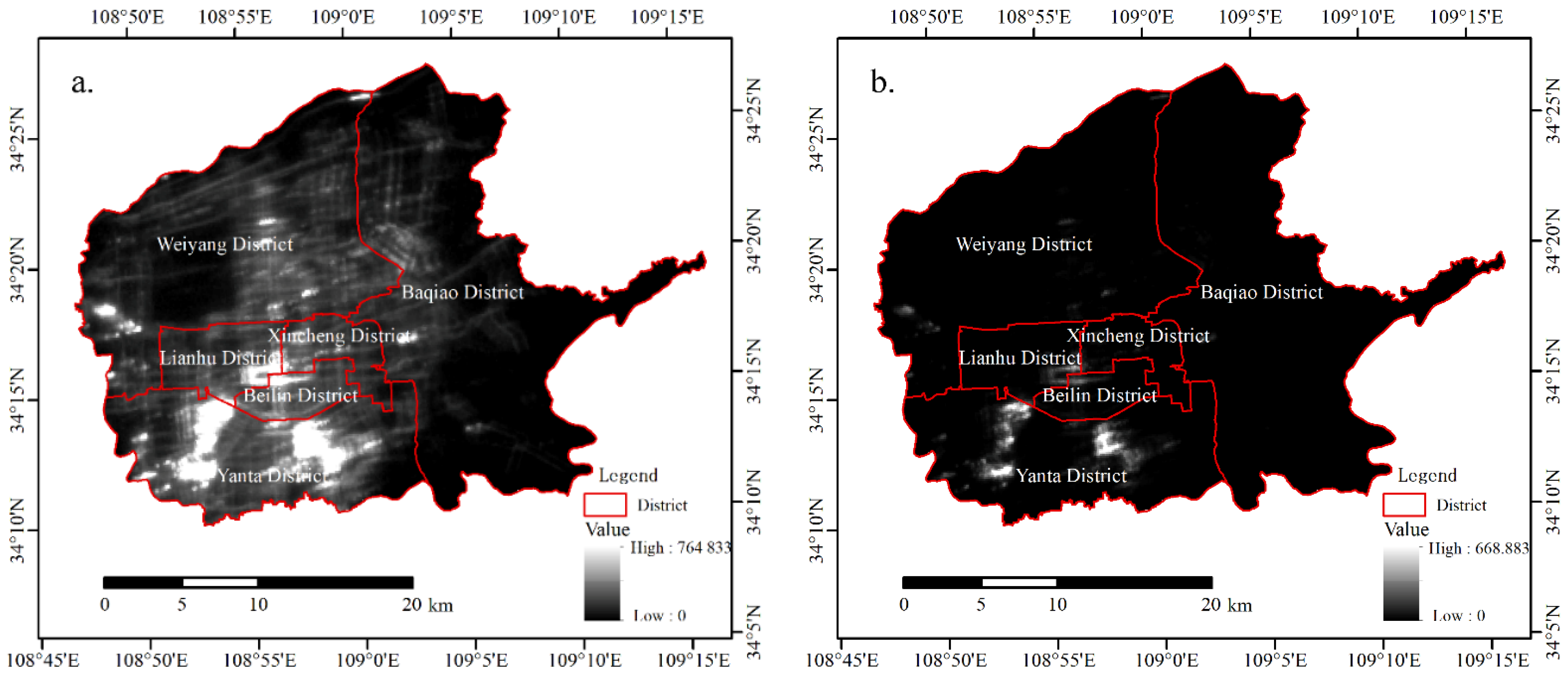
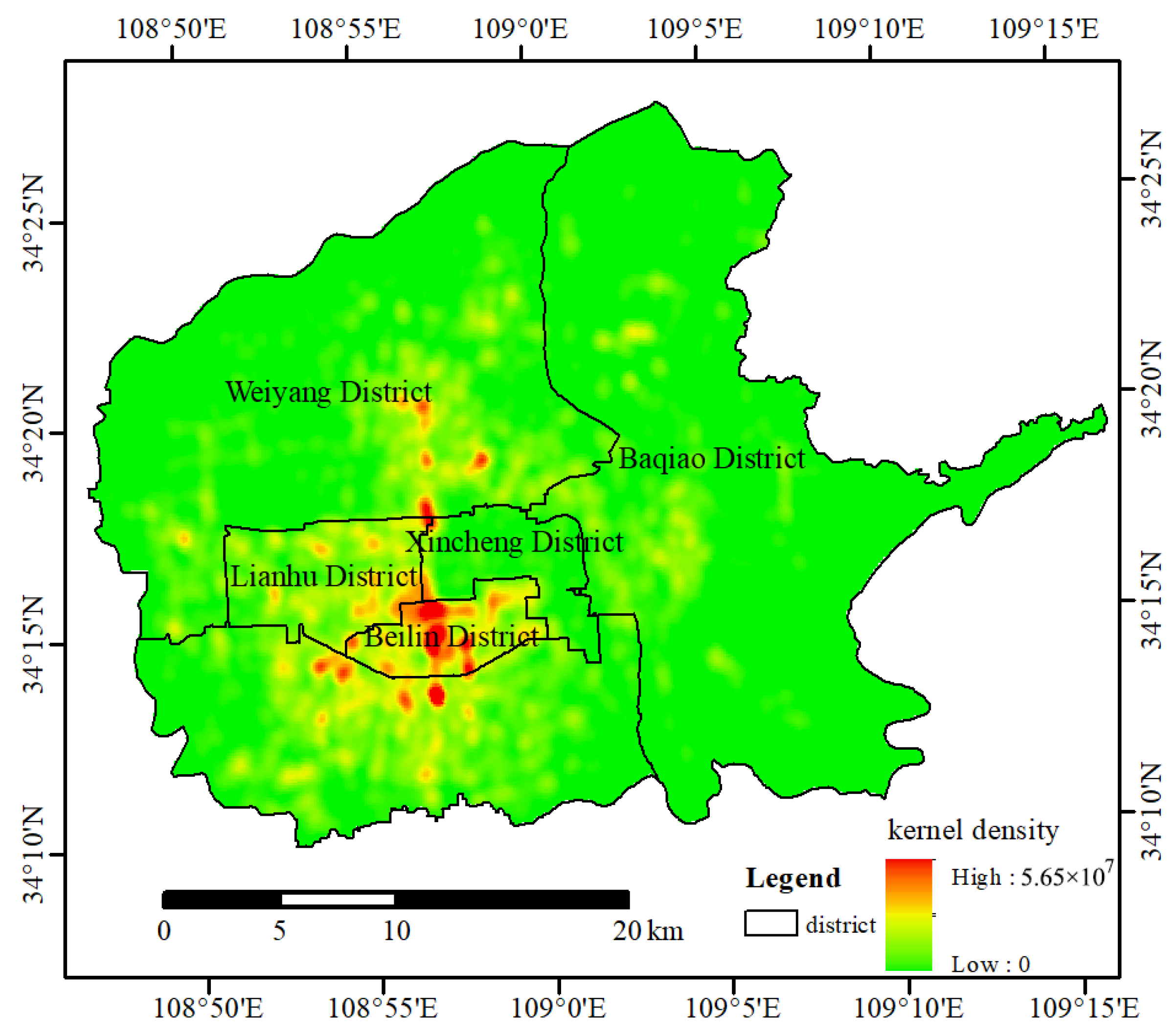

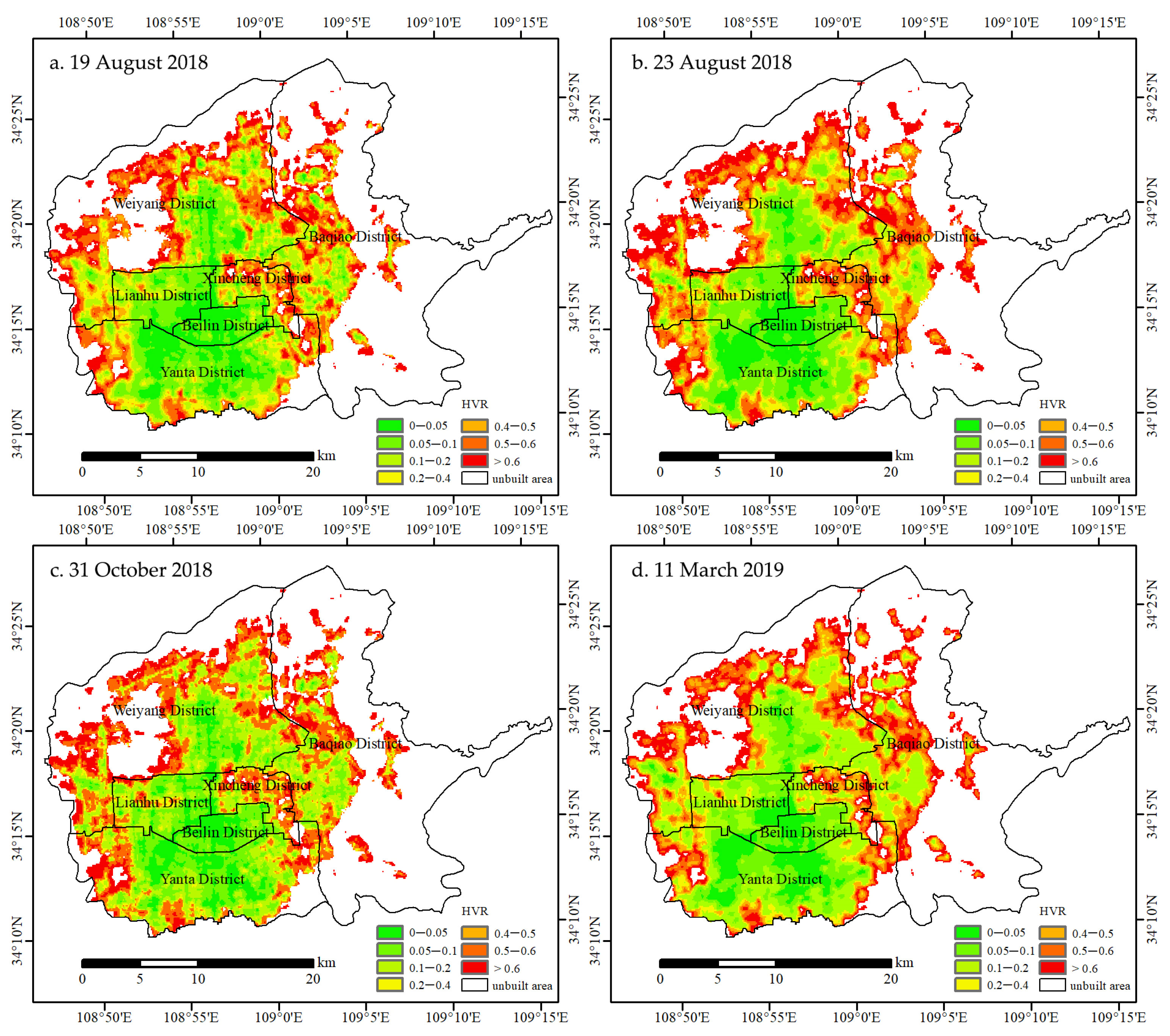
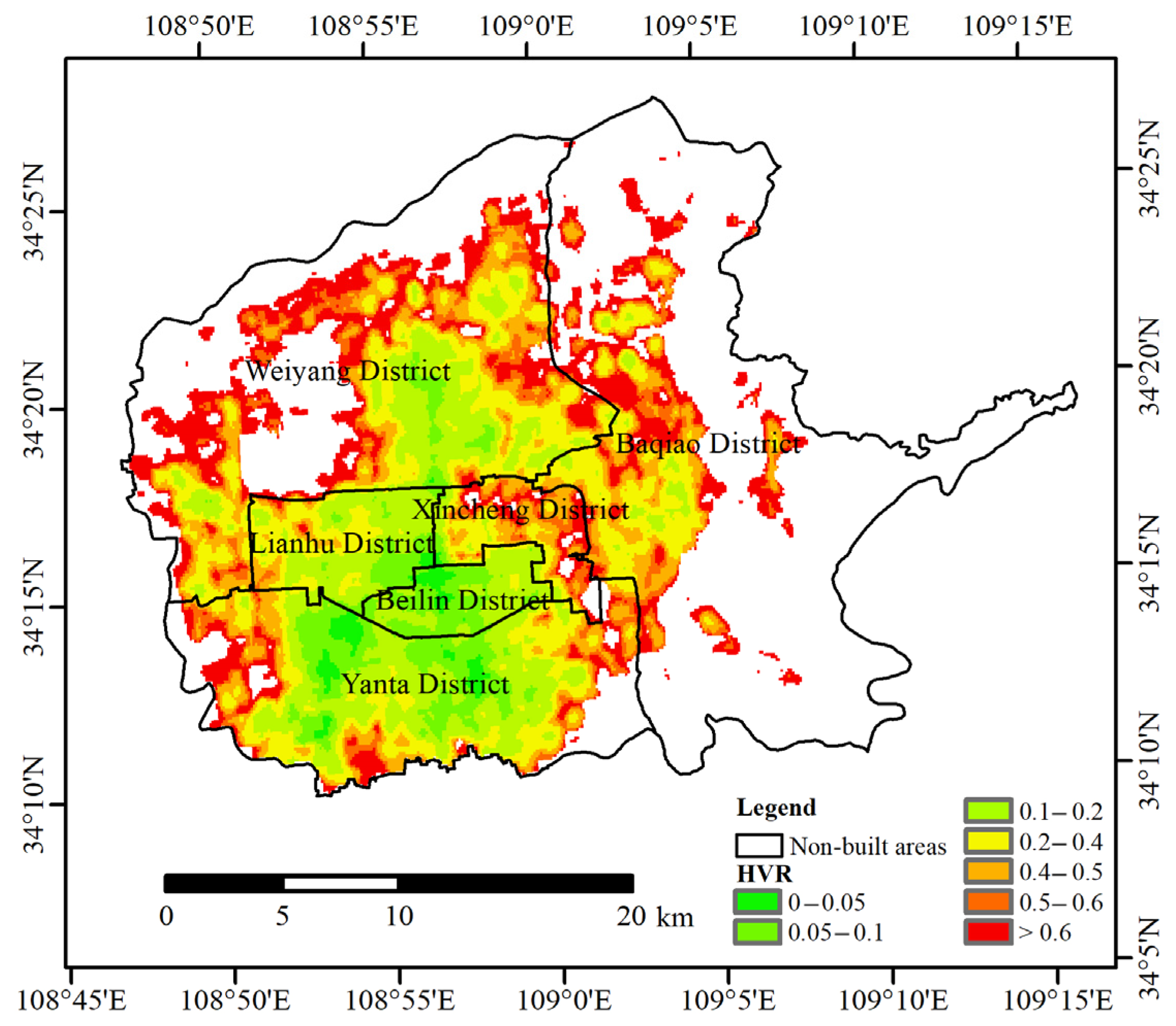

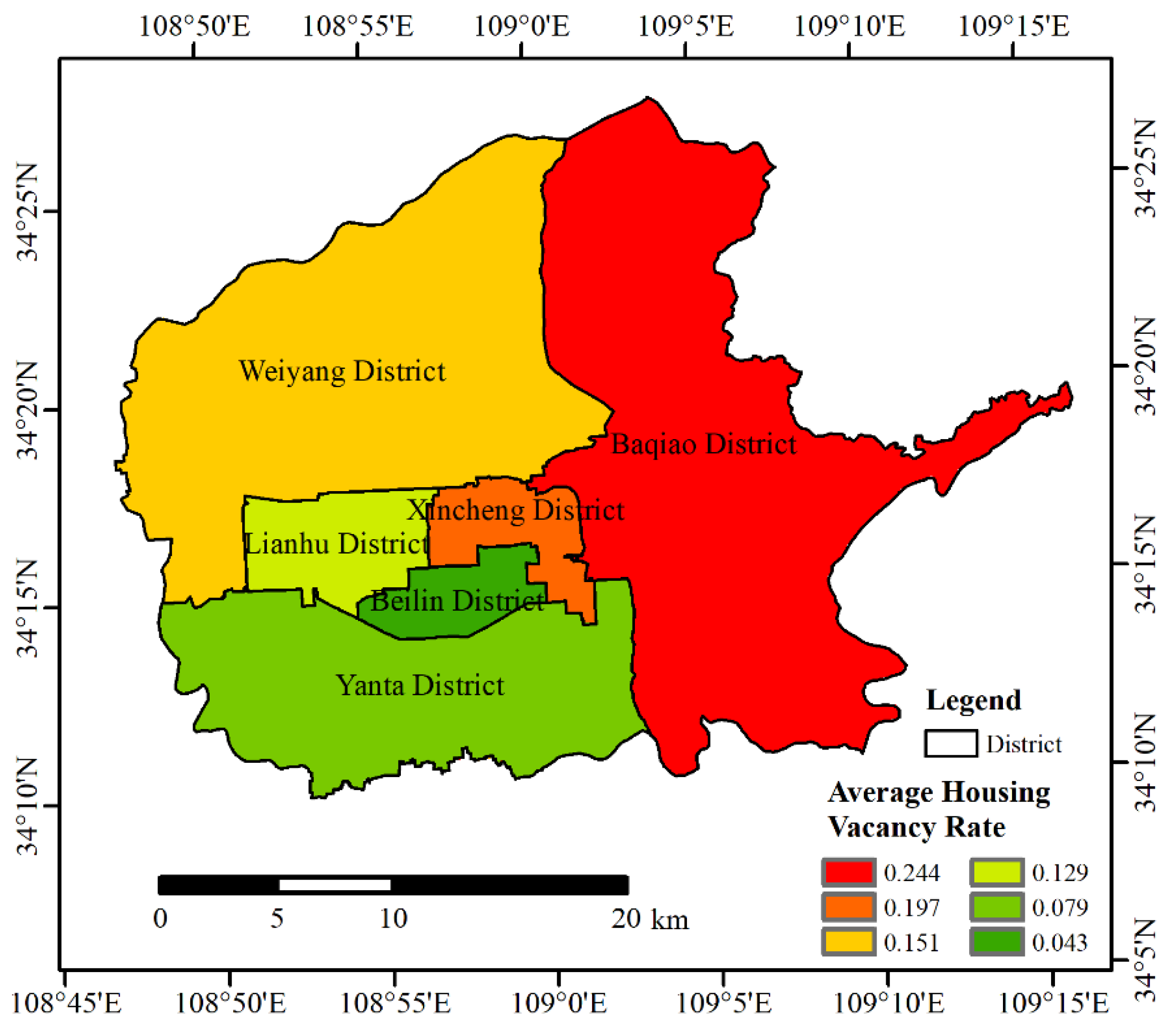
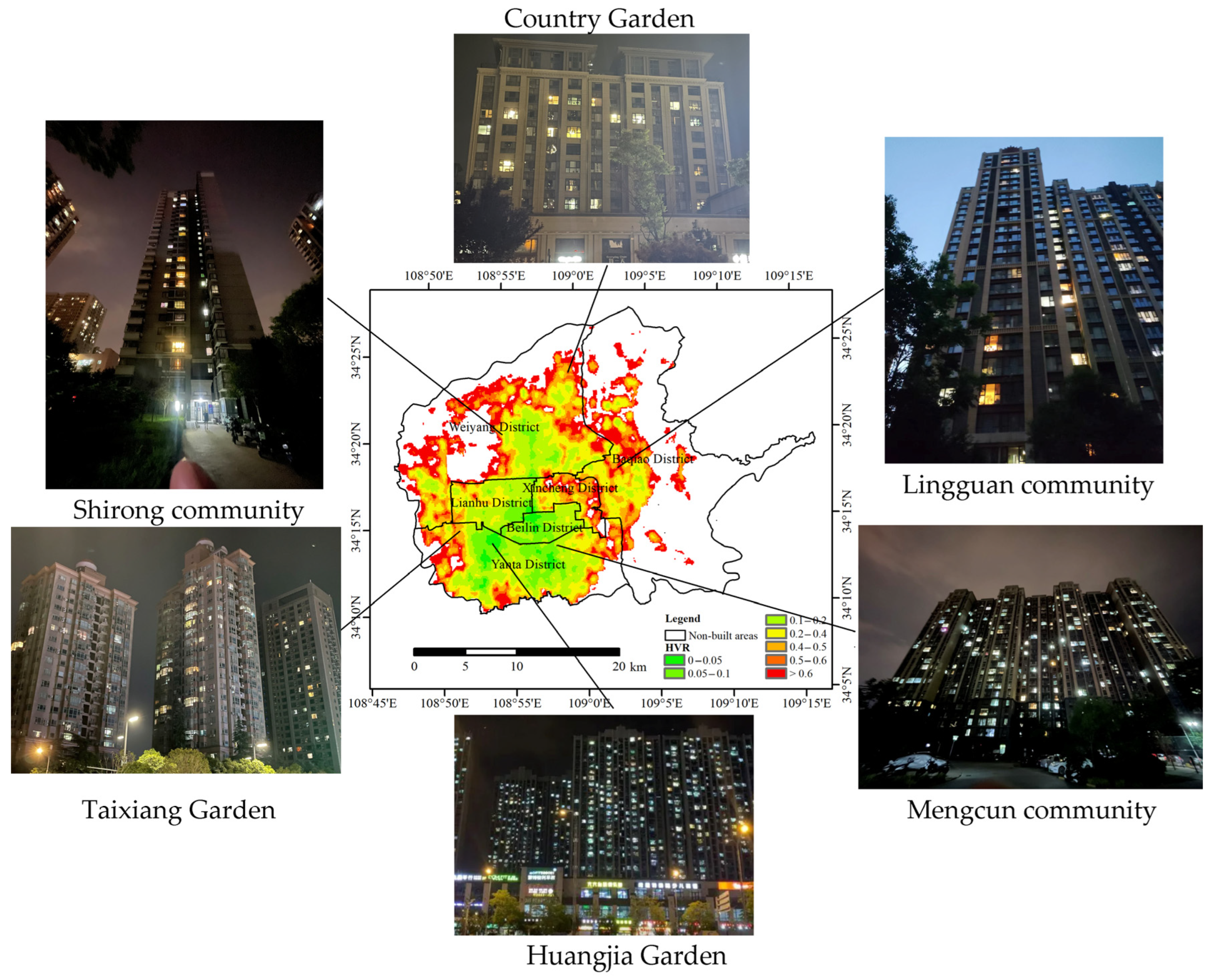
| Data Source | Country | Number of Data Bits | Spatial Resolution/m | Time in Orbit | Revisit Cycle | Width/km |
|---|---|---|---|---|---|---|
| NPP/VIIRS | America | 6 | 500 | 2011–present | 12 h | 3000 |
| DMSP/OLS | America | 14 | 1000 | 1992–2013 | 12 h | 3000 |
| Luojia-1 | China | 15 | 130 | 2018–present | 3–5 d | 250 |
Publisher’s Note: MDPI stays neutral with regard to jurisdictional claims in published maps and institutional affiliations. |
© 2022 by the authors. Licensee MDPI, Basel, Switzerland. This article is an open access article distributed under the terms and conditions of the Creative Commons Attribution (CC BY) license (https://creativecommons.org/licenses/by/4.0/).
Share and Cite
Yang, P.; Pan, J. Estimating Housing Vacancy Rate Using Nightlight and POI: A Case Study of Main Urban Area of Xi’an City, China. Appl. Sci. 2022, 12, 12328. https://doi.org/10.3390/app122312328
Yang P, Pan J. Estimating Housing Vacancy Rate Using Nightlight and POI: A Case Study of Main Urban Area of Xi’an City, China. Applied Sciences. 2022; 12(23):12328. https://doi.org/10.3390/app122312328
Chicago/Turabian StyleYang, Pengfei, and Jinghu Pan. 2022. "Estimating Housing Vacancy Rate Using Nightlight and POI: A Case Study of Main Urban Area of Xi’an City, China" Applied Sciences 12, no. 23: 12328. https://doi.org/10.3390/app122312328
APA StyleYang, P., & Pan, J. (2022). Estimating Housing Vacancy Rate Using Nightlight and POI: A Case Study of Main Urban Area of Xi’an City, China. Applied Sciences, 12(23), 12328. https://doi.org/10.3390/app122312328







